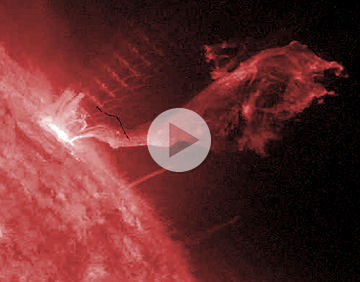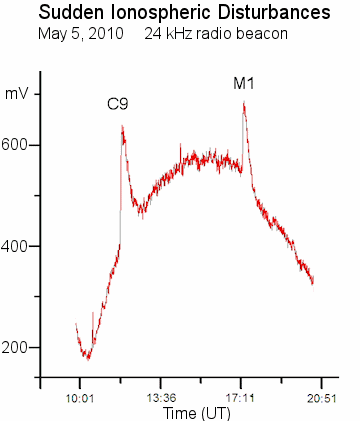NEW AND IMPROVED: Turn your iPhone or iPod Touch into a field-tested global satellite tracker. The Satellite Flybys app now works in all countries. | | | AURORA OUTLOOK: High latitude sky watchers should be alert for auroras on May 11th. That's when a disturbance in the solar wind (a "co-rotating interaction region") is expected to move past our planet and possibly disturb polar magnetic fields. NOAA forecasters estimate a 30% chance of geomagnetic activity. AMAZING ERUPTIONS: This weekend, magnetic fields around sunspot 1069 became unstable and erupted--over and over again. On May 8th alone, the active region produced more than half a dozen flares. NASA's Solar Dynamics Observatory (SDO) video-recorded each of the explosions with a clarity ten times better than HDTV. Click on the image to view a sample "first look" movie: 
Movies: 1.8 MB mpg (web), 0.7 MB m4v (iPad), 0.3 MB m4v (iPhone)
On the Richter scale of solar flares, the eruption you just witnessed registered C2.4. In years past, solar physicists regarded C-flares as minor events, but SDO is revealing them to be quite spectacular. Plasma plumes accelerating out of the blast site are filled with magnetized gas hotter than 80,000 K and are big enough to swallow Earth itself. Earth was not, however, in the line of fire, so we will feel no geomagnetic effects from these events. Here are three more highlights from May 8th: C1.8-flare, C9-flare, B7-flare. These were selected from the Lockheed Martin Solar and Astrophysics Laboratory's excellent latest events web site. Instigating sunspot 1069 has rotated over the sun's western horizon, out of sight of Earth and SDO, so the show is over for now. It probably won't be long, however, before SDO turns another "minor" eruption into a jaw-dropping spectacle. Stay tuned. BONUS: SDO also observed a pair of impressive eruptions on May 5th: This one sent a "solar tsunami" rippling through the sun's atmosphere and this one propelled a massive magnetic filament off the sun's southwestern limb. IONOSPHERIC DISTURBANCE: On May 5th, a pair of solar flares bathed Earth's upper atmosphere in X-rays and caused a double-wave of ionization to sweep over the Americas. This improved the propagation of low-frequency radio signals, which use the ionosphere as a reflector to skip over the horizon. Rogerio Marcon of Campinas SP Brasil was monitoring a 24 kHz aviation beacon when the flares occurred, and he recorded a double-surge in the beacon's signal strength: 
Each of the spikes is called a "SID," short for sudden ionospheric disturbance. One was produced by a C9-class flare at 11:52 UT; the other by a slightly stronger M1-class flare at 17:19 UT. The two SIDs ride atop a slower undulation in radio signals caused by the daily rising and setting of the sun. In terms of radio propagation, the two flares were as significant as the sunrise itself! With solar activity on the rise, sudden ionospheric disturbances will become more common. Interested? Stanford University tells you how to build your own SID monitor.
May 2010 Aurora Gallery
[previous Mays: 2008, 2005, 2004, 2003, 2002] [aurora alerts] | 
